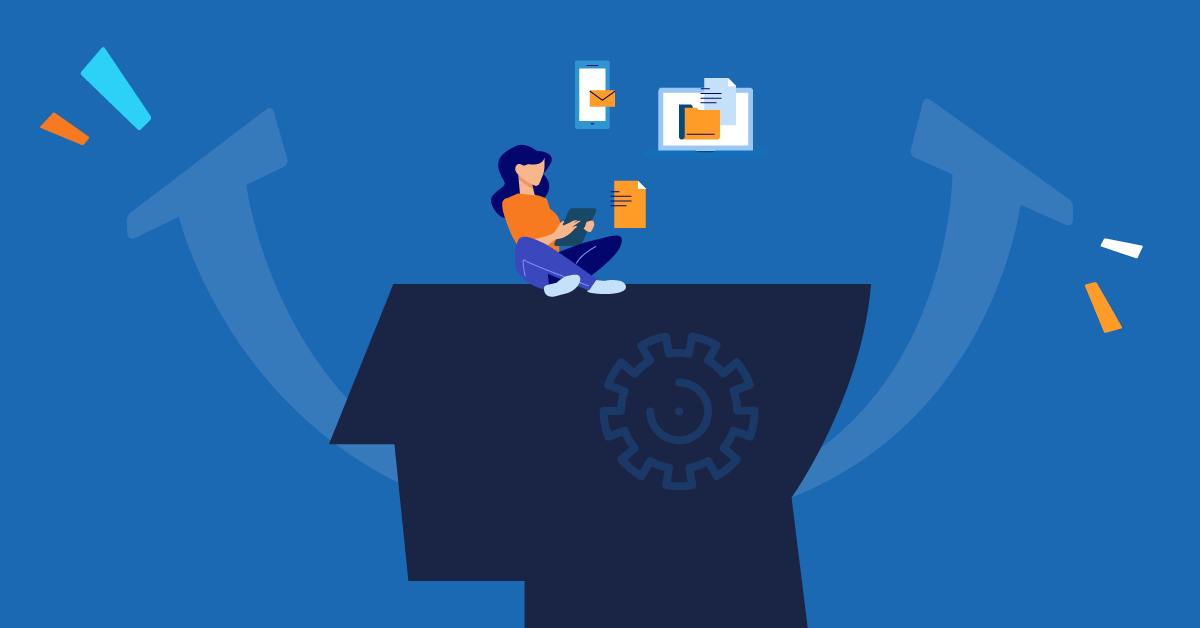As we’ve had time to explore generative AI tools like ChatGPT and Google Bard, we’ve learned about the amazing possibilities they offer. But we’ve also started to see their limits. As handy as these resources are, are they making us a bit too comfortable to notice the downsides?
By now, we know that generative AI isn’t always accurate or reliable.
Ronald Ashri supports on “Preparing for the AI-workforce”, from TalentLMS’ podcast series, Keep It Simple, that these tools are very confident to tell you what you should do. But they’re not always trustworthy.

Yet, even with that knowledge, many still fall into the trap of accepting outputs at face value simply because they’re easy to access. This failure is called “availability bias,” and it can be a big danger to your company’s future success.
Think about it like this: You’re at a buffet with endless choices. But you end up gobbling down way too many desserts just because they’re right there, easy to grab.
It’s the same with availability bias in AI. The output is right in front of us, so our brains think it’s the best option. And that’s where we’ve got to be cautious.
What is availability bias?
Availability bias is the tendency to make decisions based on information, stories, and examples that are immediately available to us. We’re mentally wired to take shortcuts in drawing conclusions.
Our brains like to work efficiently, so if we’ve got information that serves our purpose, we’re often happy to rely on it without further investigation.
Let’s look at a couple of examples of availability bias in action.
- A wary traveler overestimates the dangers of flying based on media coverage of recent plane crashes.
- A medical professional diagnoses a patient with a condition they’ve encountered recently because it’s fresh in their memory.
The human tendency to rely on information that’s easy to access has also grown to include availability bias in AI.

Availability bias in the era of information overload
Years ago, before the internet, people did extensive research to find one piece of information. It involved scouring news reports and finding original sources. Then weighing the results to draw a conclusion.
Now, with so much knowledge at our fingertips at any given time (thanks to our powerful, portable smart devices), research has become a simple task. Often our acceptance of what we find has become just as simple. It’s not uncommon for us to read something online and think it’s true without using our judgment.
AI makes narrowing down our results even simpler. Unlike a search engine, which returns a wide range of data sources when you ask a question, AI is designed to return one response it calculates as the most accurate. And when we see one answer, it’s easy to take it as the answer and move on.
An overreliance on readily available information can be harmful to businesses as well as individuals.
The paradox of availability
Access to more information faster than ever provides limitless growth opportunities. At the same time, having so much info readily available can limit our efforts if we’re not careful.
The modern marvels of search engines, and now AI, have created a deluge of information. Often, rather than sort through a seemingly overwhelming pile of data, we rely on availability bias.
We take for granted what’s readily available to us. We get one approach or response to our queries, and it sticks. In the future, we base our decisions on that same piece of information.
And it becomes a cycle of limited critical thinking that can hurt us in every area of business.
If AI returns an inaccurate or incomplete result and people don’t dig any deeper, it will affect decision-making. But there are broader implications when employees don’t use critical thinking and sound judgment. For instance:
- Limited innovation: When people rely on readily available information or examples, they end up replicating existing strategies, products, or campaigns. This limits the company’s ability to grow and meet customer needs and market demands.
- Greater financial risk: Businesses might over or underestimate risks based on recent or prominent examples.AI research may suggest, for example, that you budget most of your resources for media-popular risks. Without further research, you might fail to prepare for more likely problems. Certain less publicized risks might have a greater impact on your business.
- Poor planning: Availability bias can make decision-makers focus on easy-to-recall solutions. Or on tactics that have been successful in the past. Failing to consider the full range of options can limit adaptability. And your teams will be less prepared to respond to changing market conditions.
8 ways to help your employees develop critical thinking
Critical thinking is one of the most in-demand soft skills today. It’s also the key to avoiding availability bias pitfalls in the workplace. Balancing access to information and critical thinking takes planning and effort. But it will pay off with a more adaptable and innovative workforce.
Here are eight ways you can help your people hone their critical thinking skills to overcome availability bias:
1. Offer training and workshops
Provide regular training sessions and workshops focused on critical thinking skills. These sessions might include interactive exercises, case studies, and discussions.
Each activity should challenge employees to question assumptions, consider alternative perspectives, and evaluate information critically.
Help your people make better decisions
Boost creativity and critical thinking with TalentLMS.
The training platform that users consistently rank #1.
2. Build diverse teams
Diversity fosters a wider range of perspectives. It can help reduce the reliance on easily accessible information. Encourage team diversity by bringing together people with different backgrounds, experiences, and viewpoints.
3. Encourage critical questioning
Establish a culture that encourages employees to play the role of devil’s advocate. Foster healthy questioning during discussions and decision-making processes.
This helps uncover potential biases. It also prompts people to consider alternative viewpoints they might not see at first.
4. Require data-driven decision-making
Promote the use of data and evidence in decision-making. Cut down on cognitive biases in decision-making by encouraging employees to gather and analyze relevant data. Then prompt them to consider this data before making judgments or drawing conclusions.
5. Educate employees on AI essentials
Ensure employees understand the risks (as well as the benefits) of using AI in their work. Teaching them how to use the tech responsibly will not only prevent the side effects of availability bias. It will also help them harness the power of AI more effectively.
Meet TalentLibrary™
A growing collection of ready-made courses that cover the soft skills
your teams need for success at work
![]()

6. Seek out external perspectives
Invite outside experts or consultants to provide input on key decisions. External perspectives can challenge internal assumptions. They also provide fresh insights that help counteract the influence of availability bias.
7. Support continuous learning
Offer chances for ongoing learning and development. Include courses and resources focused on cognitive biases, critical thinking, and decision-making. Employees can develop a deeper understanding of biases and learn strategies to overcome them.
8. Establish feedback and review processes
Set up feedback and review opportunities for decisions you make within the organization. Allowing for open discussions about the decision-making process, including the role of availability bias, encourages learning and improvement over time.
Empower your business with AI and tech innovations for lasting success
Embracing AI and other tech innovations isn’t just a trend. It’s a chance to unlock amazing possibilities and set your business up for a bright future.
That means not only implementing new tools but also growing your employees to better leverage them.
By preparing your teams to use new technologies, you’re taking advantage of exciting chances for growth. And helping your business keep its edge in a world that’s getting smarter by the second.
| Tags: AI,Employee Training



